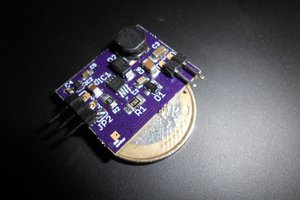Features:
- ESP8266 module, with SMT programming header (I spared the USB interface, so program it with a pogo-pin programming jig)
- TPS62135 DC/DC converter with 5-17 volt input range and up to 4 A output current at 5 V. Short circuit protection, over-temperature protection.
- 3.3-V LDO, the classic AZ1117 for the ESP supply. This is fed from the DC/DC to increase efficiency and reduce waste heat.
- 74HCT244 bus driver supplied with 5 V to drive the MOSFETs.
- AO3400 n-channel MOSFETs for the 12-V LED strips.
- The bus driver buffers the smart LED strip's DATA signal, so it is fed at 5-V level.
- Protection diodes on the data line.
- Header for 3 PIR motion sensor modules, which enables directional motion sensing. Very useful for corridors.
- User input for a hall effect sensor.
- No screw terminals! DC barrel jack for input, and direct soldering or pin header for the LED strip.
So as mentioned before, this is a dual function LED strip diver. If you use it with 12-V RGBW strips, you must run it with a 12-ish volt power supply (should work between 10 and 14 V). There's no power conditioning applied there.
But if you use it for WS2812 or compatible smart LED strips, you can use a power adapter with DC voltages between 5 and 17 V. The higher the input, the less current it needs, so you can save on copper.
I'm planning to build a dozen of these for myself to create a colorful effect lighting for a long corridor. With the 3 PIR motion sensor modules looking at different angles, the direction of motion can be determined, and as the modules communicate over network, the next strip can be dimmed up before it senses the person. I have not tested this yet, but it should be a very nice feeling to have your home react to your presence.
For the firmware I'm planning to use esphomelib and Home Assistant as software backend.
I have received 3 pcs of the v1.0 prototype PCBs, and I'm waiting for components to arrive. I already have a few changes in mind for v1.1:
- Add support for APA102 and similar synchronous-mode LED strips.
- I'll add vias for the backside programming header, so a 3D-printed jig will be unnecessary.
 Zoé
Zoé
 Ken Yap
Ken Yap
 Tinic Uro
Tinic Uro
 Enrico
Enrico
 Christoph Tack
Christoph Tack